Circle Triangle Symbol Meaning Explained
The circle within a triangle symbol is rich in historical, cultural, and philosophical meaning. In ancient Egypt, it connected to the trinity of gods and the Eye of Horus.
In Hinduism, it embodied the union of the individual soul with the universal spirit. Alchemists saw it as the harmonious balance necessary to achieve enlightenment and the Philosopher's Stone.
This symbol also features prominently in Freemasonry to represent the synthesis of spirit and matter. Its esoteric significance bridges various religious and mystical interpretations, from the Holy Trinity in Christianity to the unity of physical and spiritual domains in Buddhism.
Explore its profound depths further.
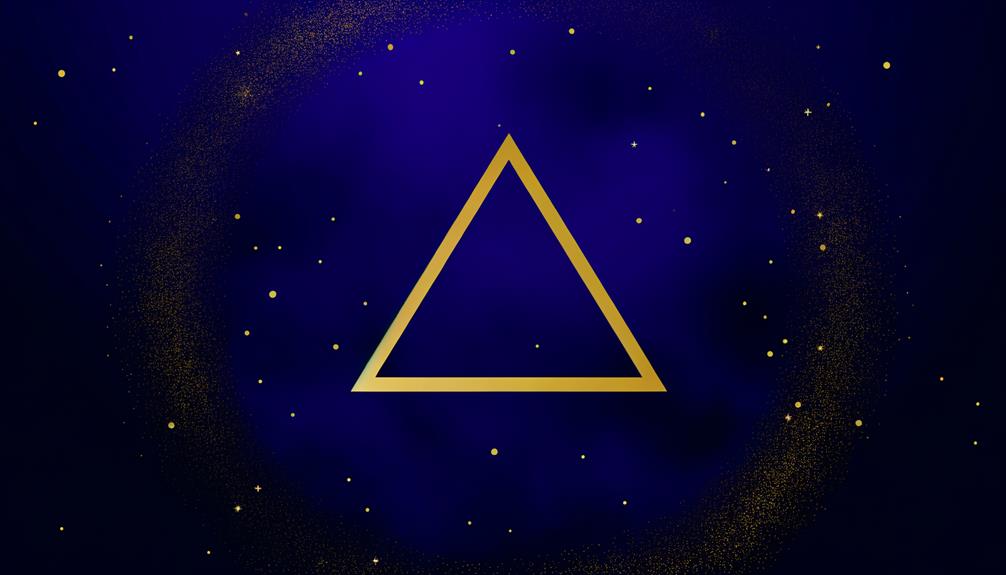
Key Takeaways
- The circle in a triangle symbolizes the union of spirit (circle) and matter (triangle).
- It represents the journey towards spiritual enlightenment and self-realization.
- In alchemy, it encapsulates the transformative process of achieving the philosopher's stone.
- It signifies the balance between physical, mental, and spiritual domains.
- The symbol bridges esoteric traditions and religious beliefs, representing cosmic unity and harmony.
Historical Origins
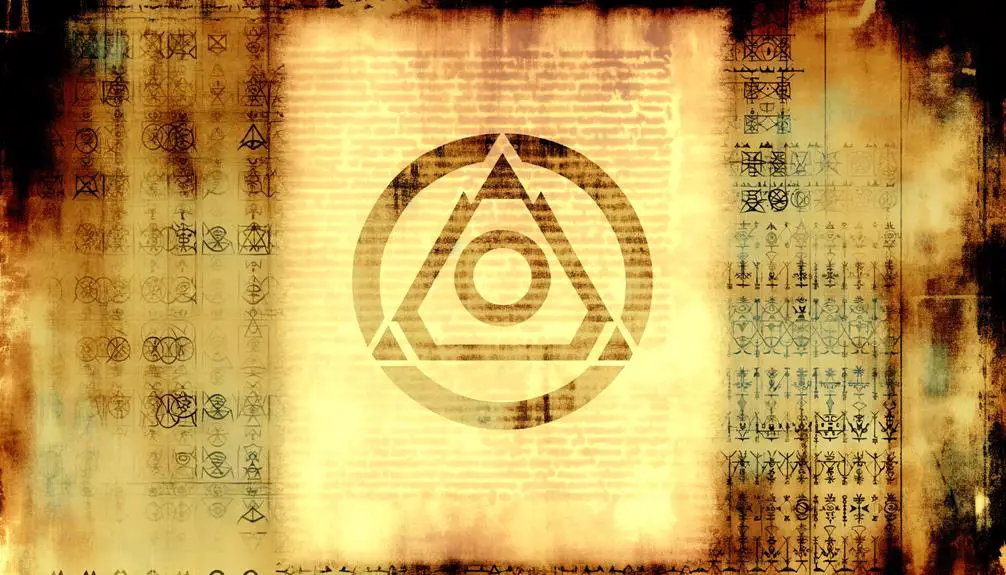
The symbol of a circle within a triangle has ancient origins, tracing back to various cultures and philosophical traditions where it represented concepts such as unity, balance, and the interplay between the material and the spiritual.
In ancient Egypt, the triangle was often seen as a representation of the trinity of gods, while the circle symbolized eternity and the divine.
Similarly, in Greek philosophy, the circle within a triangle was emblematic of the harmonious relationship between the cosmos (circle) and earthly existence (triangle).
This symbol also appears in Hinduism, where it signifies the merging of the individual soul with the universal spirit.
Over centuries, the recurring use of this symbol underscores its profound resonance across different civilizations and belief systems.
Alchemical Significance
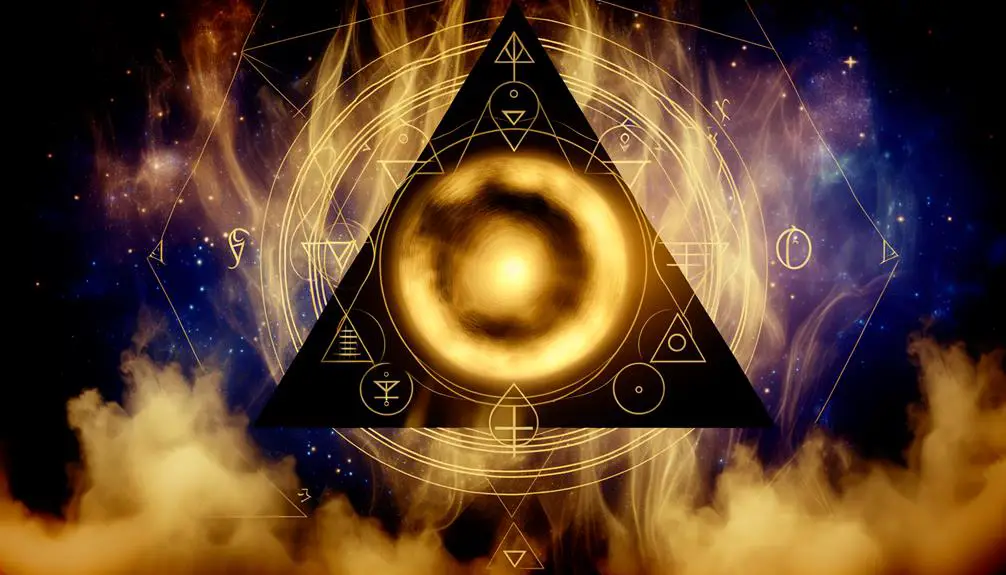
In the field of alchemy, the circle within a triangle symbol encapsulates the transformative process of achieving the philosopher's stone, representing the union of spirit (circle) and matter (triangle).
Historically, alchemists viewed this symbol as embodying the quintessential goal of their practice—the transmutation of base elements into noble ones, and the spiritual ascension of the soul. The triangle, often seen as the trinity of body, soul, and spirit, frames the circle, which signifies eternal unity and perfection.
This interplay underscores the alchemical belief in the interconnectedness of the physical and metaphysical domain. By merging these shapes, alchemists illustrated the harmonious balance necessary for enlightenment and the attainment of ultimate wisdom.
Religious Interpretations
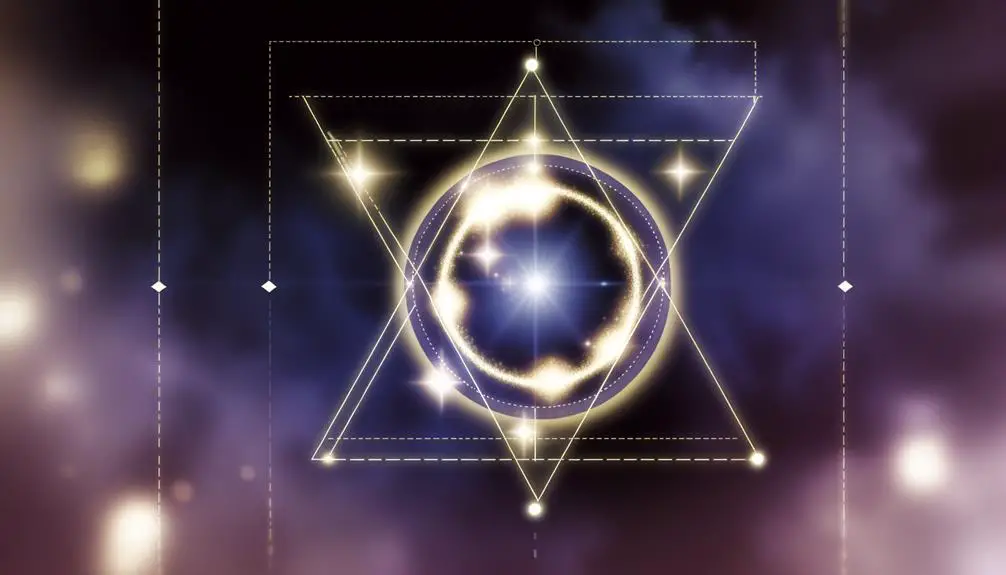
How does the circle within a triangle symbol transcend its alchemical roots to find profound resonance in various religious traditions?
Historically, this symbol has been embraced for its potent representation of unity and the divine.
In Christianity, it is often interpreted as the Holy Trinity encapsulating the eternal perfection of God, symbolized by the circle.
Similarly, in Hinduism, the circle within the triangle can represent the interplay of male and female energies, encapsulated within the sacred geometry of the Sri Yantra.
Buddhism interprets it as the unity of the physical and spiritual domains.
These religious interpretations highlight the circle in a triangle as a universal symbol, bridging diverse beliefs through its intrinsic representation of cosmic order and spiritual wholeness.
Mystical Perspectives
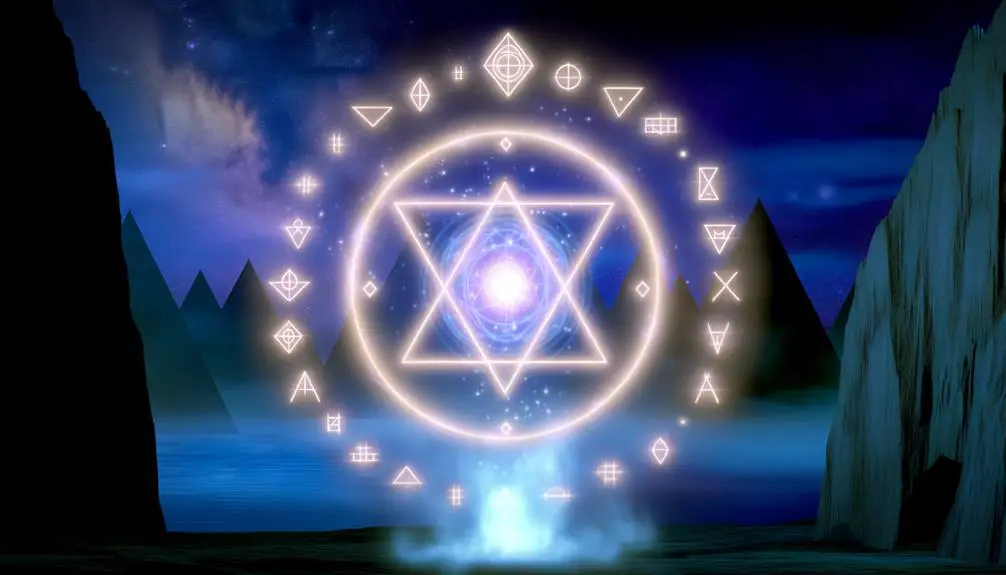
From a mystical perspective, the circle within a triangle symbol has been revered across various ancient cultures for its profound esoteric insights. Alchemical traditions often interpreted this symbol as representing the unity of spirit (circle) within the trinity of matter (triangle), highlighting a journey towards spiritual enlightenment.
This emblematic convergence underscores its enduring spiritual significance, inviting contemplation of the interconnectedness between the material and the ethereal.
Ancient Symbolism Insights
While examining the emblem of a circle within a triangle, one uncovers a profound tapestry of ancient mystical symbolism that transcends mere geometric representation. Historically, this symbol has been revered across various cultures, often embodying the unity of opposites and the interconnection of celestial and terrestrial domains.
In ancient Greek philosophy, the triangle symbolizes the trinity of mind, body, and spirit, while the circle signifies infinity and wholeness. Similarly, in Kabbalistic traditions, this emblem represents the harmonious balance between divine emanations and earthly existence.
The convergence of these shapes within a single icon encapsulates the quest for spiritual enlightenment and the transcendence of dualities, providing a timeless attestation to humanity's enduring pursuit of wisdom.
Alchemical Interpretations
In alchemical traditions, the symbol of a circle within a triangle is often interpreted as a profound representation of the synthesis of matter and spirit, encapsulating the transformative journey towards the philosopher's stone. This emblematic image carries multiple layers of meaning, deeply rooted in historical and mystical contexts:
- The Triangle: Represents the trinity of body, soul, and spirit.
- The Circle: Symbolizes eternity, unity, and the cyclical nature of transformation.
- Alchemical Process: Reflects the stages of purification, dissolution, and coagulation.
- Philosopher's Stone: Denotes the ultimate goal of alchemy, achieving enlightenment and perfection.
- Hermetic Principles: Embodies the maxim 'as above, so below,' indicating the harmony between the macrocosm and microcosm.
These interpretations reveal the symbol's rich alchemical significance.
Spiritual Significance Explained
Interpreted through mystical lenses, the symbol of a circle within a triangle transcends its alchemical roots to embody a profound connection between the material and spiritual domains. It signifies an individual's quest for holistic enlightenment and inner harmony.
Historically, the triangle represents the trinity of mind, body, and spirit, while the circle symbolizes the eternal, cyclical nature of existence. Together, they offer a pathway towards spiritual ascension, suggesting that true balance is achieved when these elements are harmonized.
This symbol has been embraced by various esoteric traditions, from ancient Hermeticism to modern spiritual practices, each interpreting it as a map for inner transformation. It invites seekers to explore the depth of their own consciousness, fostering unity and completeness.
Philosophical Views
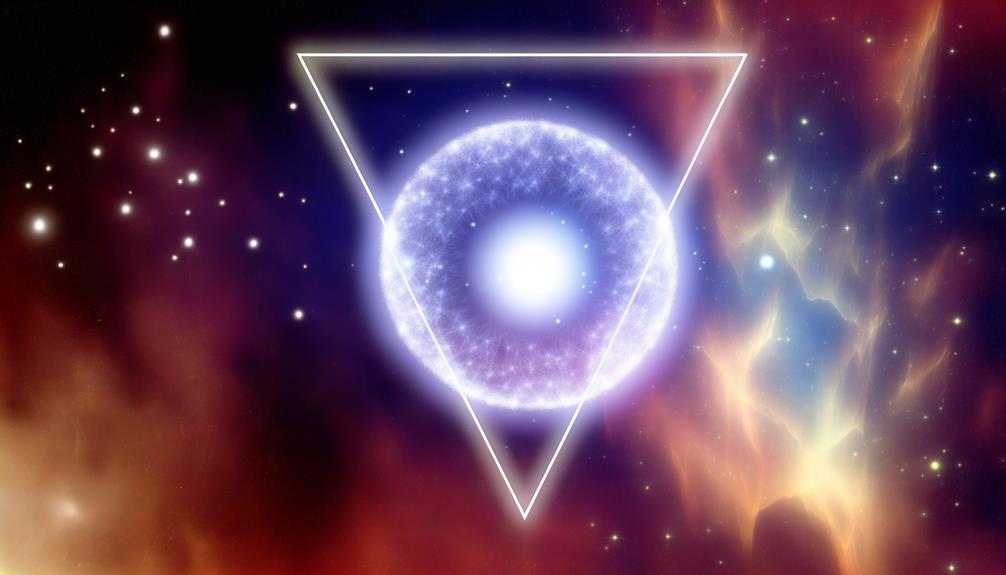
Throughout history, philosophers have imbued the symbol of a circle within a triangle with profound metaphysical significance, often interpreting it as a representation of the unity of opposites or the harmony of fundamental elements. This symbol is rich in philosophical connotations, reflecting deep-seated ideas about the nature of existence and reality.
- Pythagorean Thought: Linked the symbol to harmony and mathematical perfection.
- Platonic Ideals: Viewed it as an embodiment of eternal truths and forms.
- Alchemy: Used it to represent the integration of body, soul, and spirit.
- Hermeticism: Interpreted it as a symbol of cosmic unity and balance.
- Jungian Psychology: Considered it an archetype of the self's wholeness.
These interpretations underscore the symbol's enduring relevance in conveying complex philosophical concepts.
Symbolism in Art
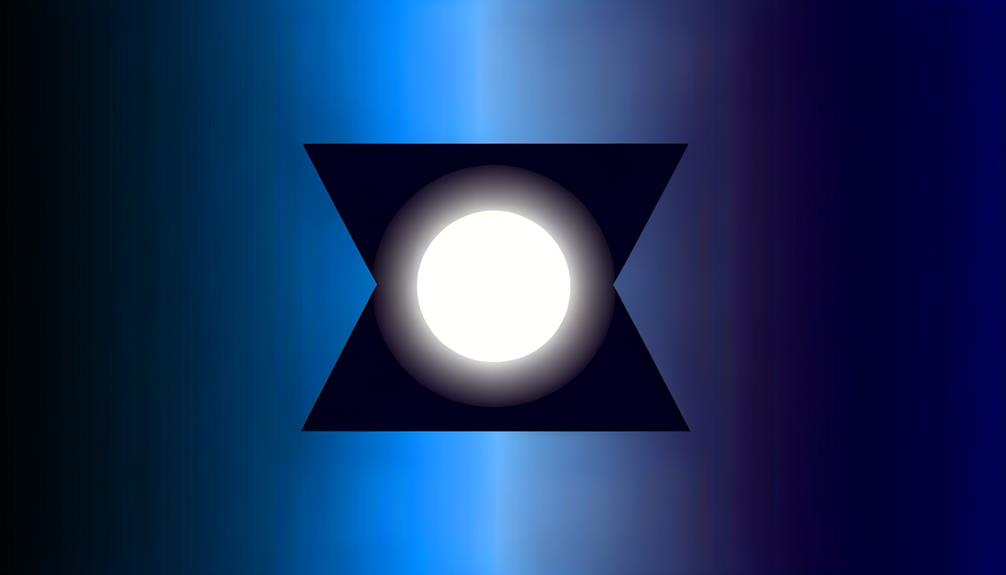
Within the world of art, the circle within a triangle has served as a potent symbol, encapsulating themes of unity, balance, and transcendence across various historical periods and cultural contexts. This symbol often appears in Renaissance masterpieces, representing the harmonious relationship between the earthly and the divine. In Eastern art, it signifies the interconnectedness of all life, merging geometric precision with spiritual insight. The symbol's recurrence across cultures underscores its universal appeal and profound interpretative depth, bridging the tangible and the abstract.
| Period | Significance |
|---|---|
| Renaissance | Earthly and divine harmony |
| Eastern Art | Interconnectedness of all life |
| Modern Art | Abstract exploration of balance |
This table illustrates the diverse yet interconnected meanings attributed to the circle within a triangle in art.
Modern Spirituality
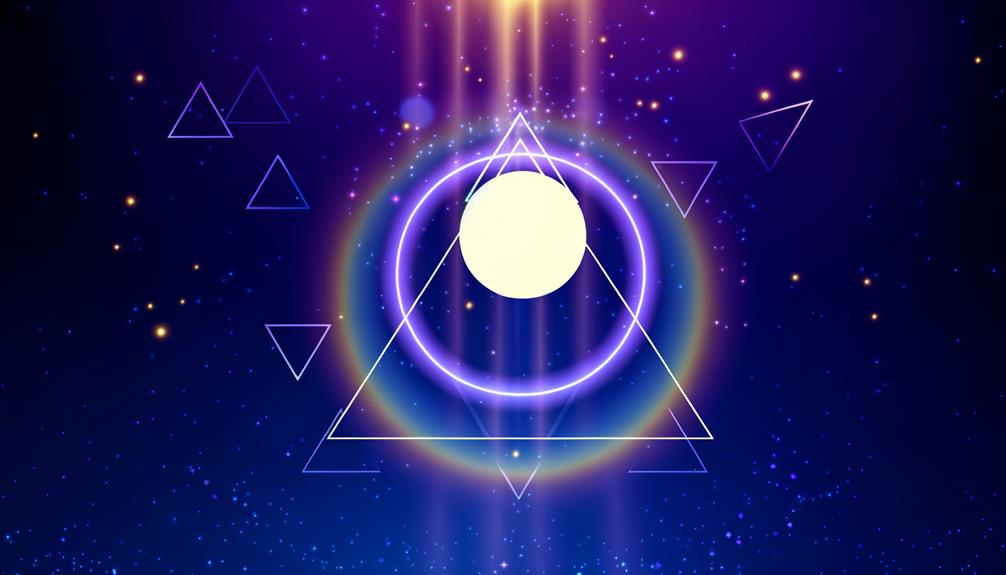
In modern spirituality, the circle within a triangle often symbolizes the integration of mind, body, and spirit, reflecting a holistic approach to personal growth and enlightenment. This emblem, with its roots in ancient traditions, has evolved to embody contemporary spiritual quests for unity and balance.
The circle represents wholeness and infinity, while the triangle denotes the trinity of existence. Together, they form a potent symbol that conveys:
- Unity of the physical, mental, and spiritual domains.
- Balance between different aspects of life.
- A journey towards self-realization.
- The interconnectedness of all beings.
- The perpetual cycle of life and enlightenment.
This synthesis highlights how modern spirituality draws from historical symbols to foster a deeper understanding of the self and the universe.
Psychological Insights
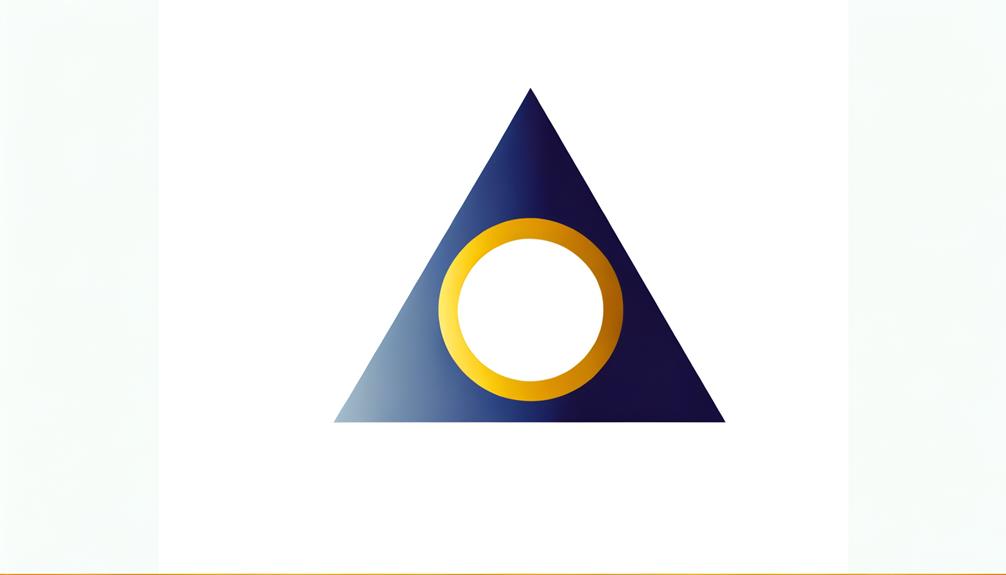
Building upon its spiritual significance, the circle within a triangle also offers profound psychological insights into the human experience and the quest for inner harmony.
Historically, the triangle has symbolized aspiration, growth, and the conscious mind, while the circle represents wholeness, unity, and the unconscious.
The intersection of these forms suggests the integration of conscious goals with the unconscious self. This synthesis aligns with Carl Jung's concept of individuation—the process of integrating various facets of the psyche to achieve a balanced self.
Therefore, the symbol encapsulates the psychological journey towards self-actualization, where personal aspirations harmonize with deeper, often hidden, aspects of our being, fostering a sense of inner peace and completeness.
Cultural Variations
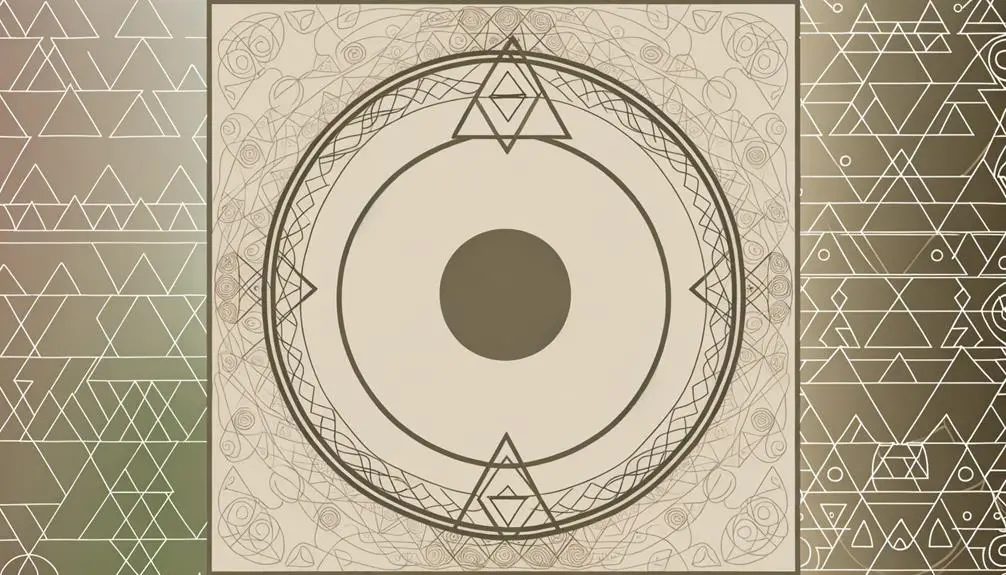
Different cultures have imbued the circle within a triangle symbol with unique meanings, reflecting their distinct historical and philosophical contexts. This geometric motif serves as a rich tapestry of interpretation across various societies.
For instance:
- Ancient Egypt: Symbolized the Eye of Horus, representing protection and royal power.
- Hinduism: Emblematic of the balance between the physical and spiritual domains.
- Celtic Traditions: Denoted the triad of life, death, and rebirth, often linked to the Triple Goddess.
- Freemasonry: Illustrated the synthesis of spirit (circle) within the material world (triangle).
- Alchemy: Embodied the unity of mind, body, and soul during the quest for the Philosopher's Stone.
Each cultural perspective adds layers of meaning, showcasing the depth and universality of this symbol.
Symbol in Popular Culture

The circle within a triangle symbol has permeated popular culture, often serving as a powerful icon imbued with layers of esoteric and mystical significance. This symbol frequently appears in literature, film, and art, representing themes like unity, protection, and enlightenment.
For instance, in J.K. Rowling's 'Harry Potter' series, the Deathly Hallows emblem—a circle within a triangle—symbolizes the quest for ultimate power and immortality. In other contexts, the symbol is linked to secret societies and alchemical traditions, invoking the pursuit of hidden knowledge.
Its recurrent use underscores a collective fascination with the convergence of the mundane and the mystical, illustrating how ancient symbols continue to captivate modern imaginations with their rich, interpretative depth.
Conclusion
The symbol of a circle within a triangle traverses a rich tapestry of interpretations, from alchemical profundities to religious symbolism and modern spiritualities. It serves as a multifaceted emblem, akin to a prism that refracts diverse meanings depending on the cultural lens.
This symbol continues to captivate the human psyche, inviting both introspection and communal identity. Its enduring presence in popular culture underscores its archetypal resonance, echoing through the corridors of history and human consciousness.






